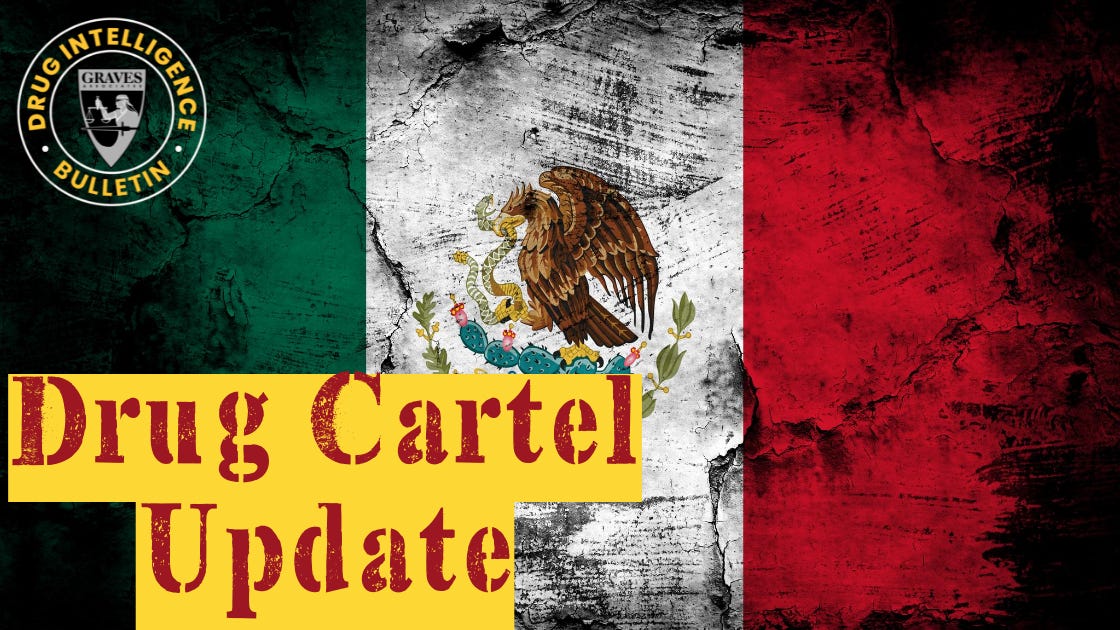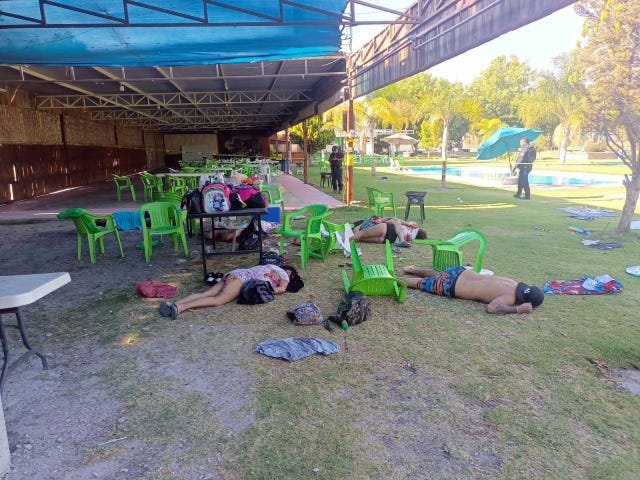Mexican Drug Cartel Update for the week of April 16, 2023
*Please be advised that our intelligence reports on drug cartels may contain graphic images and descriptions that could be disturbing to some readers. As a result of the subject matter, each intelligence bulletin may include explicit content. Proceed with caution.
El Chapo’s Sons Charged in the US
The US Justice Department has charged over two dozen people, including three sons of drug kingpin Joaquín "El Chapo" Guzmán, in a far-reaching fentanyl trafficking investigation targeting the Sinaloa cartel. Attorney General Merrick Garland revealed that the charges filed in New York, Illinois, and Washington, D.C., involve fentanyl trafficking, weapons, and money laundering. The Sinaloa cartel is accused of running the largest, most violent, and most prolific fentanyl trafficking operation globally, supported by Chinese precursor chemical and pharmaceutical companies. El Chapo's sons, known as the "Chapitos," are among those indicted.
Spanish Mega Lab Discovery Indicates New Trend in Cocaine Trafficking
Spanish police uncovered Europe's largest-ever cocaine-producing laboratory, with the potential to produce 200kg of cocaine per day. Located in Galicia, near Spain's Atlantic coast, the lab refined coca base into cocaine hydrochloride. This discovery suggests a new trend in cocaine trafficking, wherein the unprocessed drug is exported for chemical processing in clandestine labs in destination countries. Eighteen people have been arrested, including Colombian and Mexican citizens who allegedly assisted in the production process. Despite the size of the lab, large-scale cocaine production in Europe is still in its infancy. Similar, smaller-scale facilities have been found in Ireland, Italy, Portugal, and Belgium. Coca base is cheaper to buy in Latin America than finished cocaine, which could provide a financial incentive for drug traffickers to export coca base to Europe for processing.
Ecuador Gang Massacre Signals Intensifying Struggle for Drug Routes
A massacre in Esmeraldas, Ecuador, has highlighted the growing violence in the country due to competition over cocaine trafficking routes. Nine people were killed in the attack, believed to have been carried out by the Tiguerones, a major Ecuadorian gang controlling most drug trafficking in Esmeraldas. The city is a key drug trafficking hub, with cocaine from Colombia arriving and leaving through its ports. The escalating violence between the Tiguerones and local rivals, the Patones, along with other gangs, has led to record homicide rates in recent years. Ecuadorian President Guillermo Lasso declared a state of exception in Esmeraldas province in response to the violence, deploying armed forces and national police to support local forces. The ongoing competition between gangs is driven by their desire to control drug trafficking routes, as Ecuador serves as an exit point for Colombian cocaine shipments destined for the US, Europe, Australia, and Russia.

Fentanyl Trafficking Routes Shifting on US-Mexico Border?
Over the past eight months, US officials have seized more illicit fentanyl at Arizona's ports of entry than anywhere else on the US-Mexico border, hinting at a possible shift in synthetic drug trafficking routes. Between July 2022 and February 2023, the Tucson field office seized more than four tons of fentanyl, accounting for 58% of all seizures of the synthetic opioid at ports of entry along the entire US-Mexico border during that time. Previously, most fentanyl seizures were concentrated at California's ports of entry. The shift in fentanyl seizures from California to Arizona may be due in part to new technology and increased vigilance by US authorities. The Department of Homeland Security (DHS) launched "Operation Blue Lotus" in mid-March to crack down on fentanyl trafficking through ports of entry along the entire US-Mexico border. The operation's use of improved scanning technology, such as the "multi-energy portal" scanner, has likely contributed to the rise in fentanyl seizures at Arizona's ports of entry.
Red Cross Reports Mexico's Violence Similar to a War Zone
The International Committee of the Red Cross (ICRC) compared the violence in Mexico to the levels seen in an active war zone, expressing deep concern about the ongoing violence. The violence is primarily linked to crimes carried out by drug cartels. In 2022, Mexico recorded 30,968 murders, with an additional 35,625 murders in 2021, according to the ICRC report. The report also claimed that Mexico experienced over 100,000 cases of forced disappearances in 2022. The violence in Mexico in 2021 caused more than 379,000 internal displacements, a rise from 262,411 in 2020
Tamaulipas Authorities Attempt to Conceal Murder of Original Los Zetas Member in Prison
Authorities in the border state of Tamaulipas attempted to conceal the murder of an original Los Zetas member, Ciro "Cirilo" Pérez González, also known as Z-37 or Perro de Evelio, in a prison in Nuevo Laredo. González, a former Mexican army member with special forces training, was killed by two inmates from the Northeast Cartel.
Z-37 was one of the last remaining members of Los Zetas, initially recruited by the group's supreme leader, Heriberto "Z-3" Lazcano, to help expand the criminal drug organization's operations across Mexico. After joining Los Zetas, González became one of Lazcano's most trusted allies and served as the regional head of the group in Guanajuato, parts of San Luis Potosí, and northern Veracruz from 2012 to 2015.
Following his arrest in 2015, González spent several years in a state prison in Oaxaca before being released on April 10. However, Tamaulipas' Attorney General's Office agents were present at his release and re-arrested him on pending state charges for the murder of a woman and an attack on a second woman. González was stabbed over 60 times by two known members of the Northeast Cartel faction of Los Zetas, who are mortal enemies of the original Zetas.
Cartel Gunmen Kill Child, 6 Others at Waterpark in Mexico
A group of cartel gunmen stormed a waterpark in Cortazar, Guanajuato, central Mexico, and began shooting indiscriminately, killing seven people, including a seven-year-old girl. The incident occurred at the La Palma waterpark and took place at around 4:30 p.m. on Saturday. A patron recorded a short video on their cell phone, showing women and children running away from the gunfire. After the shooting, the gunmen stole the surveillance cameras and the security monitor inside the waterpark before escaping.
The municipal government confirmed the murder of three men, three women, and a seven-year-old girl. Although authorities have not released a motive for the mass shooting, Guanajuato continues to experience uncontrolled cartel violence. Factions tied to the Cartel Jalisco New Generation and a local crime group called Cartel Santa Rosa De Lima are fighting over local drug distribution and control over underground fuel theft. Cartel gunmen in Guanajuato have begun killing random, innocent victims during their attacks and have issued warnings that they will target more innocents who visit businesses tied to their rivals.
Cartel Killings Continue to Plague Cancun, Surrounding Areas
Cartel killings and kidnappings persist in Cancun and surrounding areas as factions of the Sinaloa Cartel and Cartel Jalisco New Generation fight for control of the region's lucrative drug distribution and other businesses catering to tourists. The ongoing influx of tourists to Cancun and hotspots like Playa Del Carmen, Tulum, and Isla Mujeres has fueled the violence as cartels compete for control of local drug distribution, sex trade, liquor trade, and other tourist-oriented commodities. Additionally, drug cartels have a history of extorting local businesses for protection money or forcing them to sell drugs.
Earlier this week, gunmen dumped a severed human head in Cancun, threatening Lourdes Espin Alarco, the local police chief in Isla Mujeres. This was the second severed human head dumped by gunmen in or near Cancun in two days. On Monday, gunmen dumped a dismembered body that was missing a head.
According to the Quintana Roo Attorney General's Office, El 15, or Hector Elias Flore Aceves, is a lieutenant with the Sinaloa Cartel linked to several murders in Cancun and surrounding areas. The message accused the local police chief of providing protection to his criminal group in exchange for bribes.
On Friday, gunmen shot and killed a man and injured a woman in a low-income neighborhood in Tulum. The local news outlet NotiCaribe reported 43 killings in Tulum since the start of the year. On Thursday, authorities found the body of an unidentified man who had been kidnapped earlier in the day in an abandoned construction site in Cancun.




